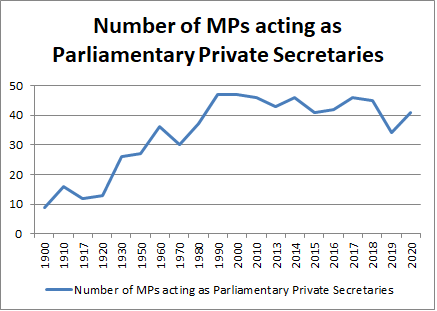The Government has published the latest list of Parliamentary Private Secretaries (PPS). I have written a number of previous posts about the role and particularly the rise in the number of Parliamentary Private Secretaries in recent years. I won’t repeat myself here other than to note that these unpaid positions are generally seen as the first rung on the ministerial ladder and, like ministers, MPs who are parliamentary private secretaries are expected to remain loyal and vote with the government. As such the offer of a position as a PPS, like ministerial office, is often seen as a carrot to guarantee support in the chamber of the House of Commons. Despite the fact that PPSs do not receive a ministerial salary the combination of paid and unpaid ministerial positions is sometimes referred to as the payroll vote.
The size of the payroll vote has increased considerably in recent years leading to criticism that governments have used this form of patronage to pack the chamber with guaranteed votes. Although the number of paid ministerial positions is limited by law, there is no cap on the number of parliamentary private secretaries.
 The latest data release indicates that there are 41 parliamentary private secretaries. This looks like a significant increase in the number of these posts under Boris Johnson. There were only 34 PPSs on the final list released under Theresa May in June 2019. However, this was perhaps more a reflection of the difficulties May faced in filling government posts as her government limped towards its demise. Previous lists released under Theresa May in 2017 and 2018 indicated there were 45 and 46 parliamentary private secretaries.
The latest data release indicates that there are 41 parliamentary private secretaries. This looks like a significant increase in the number of these posts under Boris Johnson. There were only 34 PPSs on the final list released under Theresa May in June 2019. However, this was perhaps more a reflection of the difficulties May faced in filling government posts as her government limped towards its demise. Previous lists released under Theresa May in 2017 and 2018 indicated there were 45 and 46 parliamentary private secretaries.
The total number of MPs currently holding government posts is on a par with recent governments. There are currently 80 MPs holding ministerial posts in the House of Commons and 13 serving as Whips. When combined with 41 parliamentary private secretaries this makes a payroll vote of 134 MPs. This is less than the 140 MPs holding government posts under Theresa May in 2018, and significantly lower than the high point of 148 under the coalition government in 2014.
 Moreover, while the size of the payroll vote has changed little under the current government, the size of the government’s majority means that the proportion of Conservative MPs holding government positions is considerably lower than under David Cameron or Theresa May. Only 31% of those sitting on the government benches currently hold a government post, compared to 45% even in the final months of the Theresa May government.
Moreover, while the size of the payroll vote has changed little under the current government, the size of the government’s majority means that the proportion of Conservative MPs holding government positions is considerably lower than under David Cameron or Theresa May. Only 31% of those sitting on the government benches currently hold a government post, compared to 45% even in the final months of the Theresa May government.
Many would argue for the need to address the rise in the payroll vote, including perhaps a further limit on the number of ministerial posts and a cap on the number of parliamentary private secretaries. However, as the current government may discover with significant disgruntlement on the backbenches, political patronage may only stretch so far.
